Reproduction in Flowering Plants
From an evolutionary viewpoint, all the structures and functions of a plant can be interpreted as mechanisms contributing to reproduction. Flowers, the reproductive shoots of angiosperms, vary greatly in shape among different flowering plants but most will contain four types of modified leaves called floral organs: sepals, petals, stamens, and carpels.
The sepals enclose and protect the flower bud, they are usually more leaflike than other floral organs. The petals are often colorful and fragrant to attract pollinators. The stamens and carpels are reproductive organs containing sperm and eggs, respectively.
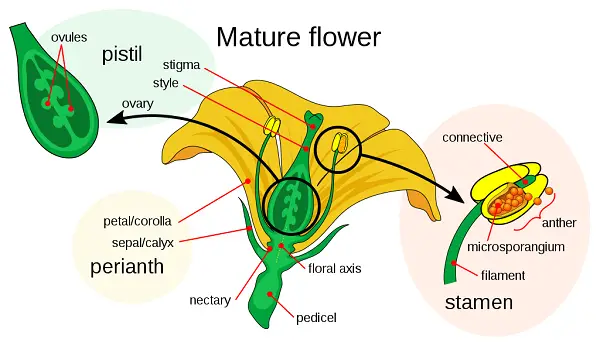
A stamen consists of a stalk (called the filament) tipped by an anther. Within the anther are sacs in which pollen is produced by meiosis. Pollen grains house cells that develop into sperm.
A carpel has a long slender neck (called the style) with a sticky stigma at its tip to capture pollen. The base of the carpel is the ovary, which contains one or more ovules, each containing a developing egg and supporting cells. The term pistil is used to refer to a single carpel or a group of two or more fused carpels.
We will now look at key stages of an angiosperm’s life cycle in more detail, starting with fertilization.
1. Plant Fertilization
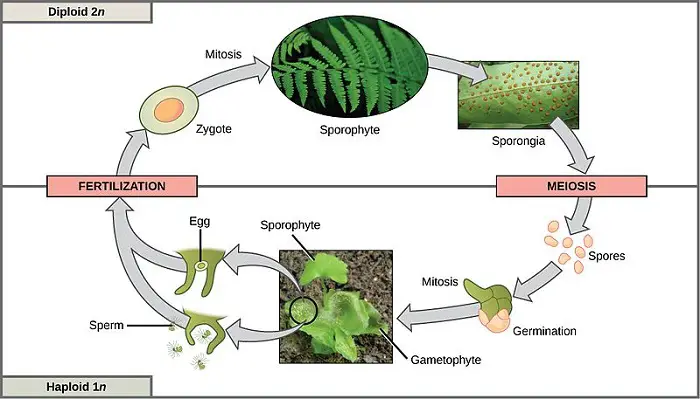
The life cycles of plants are characterized by an alternation of generations, that is a haploid and diploid generations take turns producing each other.
The diploid plant is called the sporophyte which produces special structures–the anthers and ovules, where cells undergo meiosis to produce haploid cells called spores. Each spore divides mitotically, becoming a multicellular gametophyte, the plant’s haploid generation. The gametophyte produces gametes by mitosis.
After fertilization, gametes from the male and female gametophyte unite, producing a diploid zygote. The life cycle is completed when the zygote divides by mitosis and develops into a new sporophyte. In angiosperms, the sporophyte is larger, more obvious, and longer-living than the gametophyte.
The cells that develop into pollen grains are found within the anthers. Each cell undergoes meiosis, forming four haploid spores that then divide by mitosis to form two haploid cells called the tube cell and generative cell. The generative cell passes into the tube cell, and a thick wall forms around them. The resulting pollen grain is ready to be released.
In most species, the ovary contains several ovules. An ovule contains a central cell surrounded by a protective covering of smaller cells. The central cell enlarges and undergoes meiosis, producing four haploid spores. Three of the spores usually degenerate, with the surviving one proceeding to mitosis to produce a multicellular structure known as the embryo sac. This embryo sac is the female gametophyte which contains a large central cell with two haploid nuclei. One of its other cells is the haploid egg, ready to be fertilized.
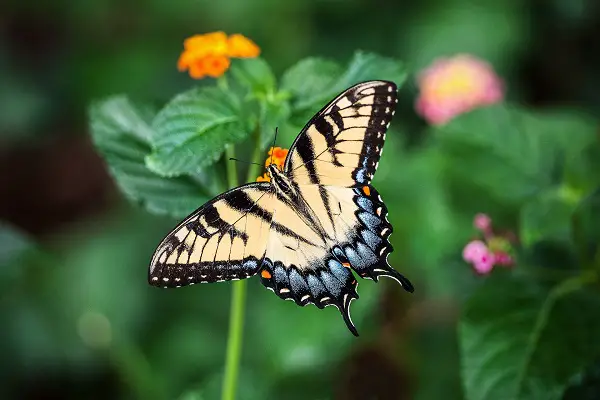
Pollination, the transfer of pollen from the anther to stigma, usually leads to fertilization. After pollination, the pollen grain germinates on the stigma. Its tube cell gives rise to the pollen tube, which grows downward into the ovary.
Meanwhile, the generative cell divides by mitosis, forming two sperms. When the pollen tube reaches the base of the ovule, it enters the ovary and discharges its two sperm near the embryo sac. One sperm fertilizes the egg to form the diploid zygote while the other fertilizes the large diploid central cell of the embryo sac, resulting in a triploid (3n) nucleus which will give rise to the food-storing tissue called endosperm.
The union of the two sperms to the different nuclei of the embryo sac is called double fertilization and the resulting endosperm is unique to angiosperms. Endosperm will develop only in ovules with a fertilized egg, thereby preventing angiosperms from wasting nutrients.
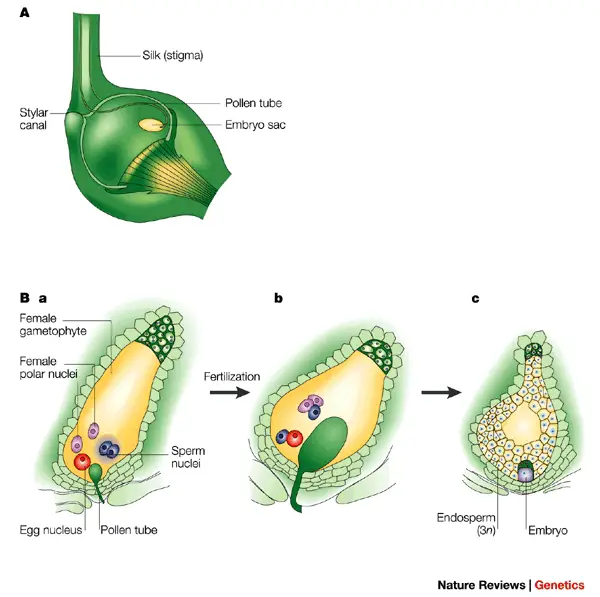
The next step in the reproduction of flowering plants is the formation of the seed and the means of protecting that offspring. All of these have the ultimate goal of ensuring that the seed survives to become a healthy plant. This will be the focus of the next section.
2. Seed and Fruit Formation
After fertilization, the ovule which contains the triploid central cell and the diploid zygote begins to develop into a seed. As the embryo develops from the zygote, the seed stockpiles proteins, oils, and starch to varying degrees.
The result of embryonic development in the ovule is a mature seed and near the end of its maturation, the seed loses most of its water and forms a hard, resistant seed coat. The embryo, surrounded by its endosperm food supply, becomes dormant and will not develop further until the seed germinates. This condition is known as seed dormancy and is a key evolutionary adaptation.
The dormant embryo contains a miniature root and shoots each equipped with an apical meristem. After the seed germinates, the apical meristems will sustain primary growth as long as the plant lives. The embryo also contains cells that will eventually form the dermal, ground, and vascular tissue systems.
While the seeds develop from the ovules, hormonal changes triggered by fertilization cause the flower’s ovary to grow, thicken, and mature into a fruit. Fruit is a matured ovary that acts as a vessel of the seed. Easily recognizable fruits include peaches, oranges, and cherries. Not so easily recognizable ones include tomatoes, eggplants, and peppers.
Mature fruit can be either fleshy or dry. Examples of fleshy fruits are those of oranges, plums, and grapes, where the ovary wall becomes soft during ripening. Dry fruits include nuts and beans whose ovary walls dry out at maturity. The dry, wind-dispersed fruits of grasses, harvested while on the plant, are major staple foods. These include cereal grains of wheat, rice, and corn, which are easily mistaken for seeds.
Various adaptations of fruits help disperse seeds. An example is that of the Narra tree, where the fruits function like kites or propellers, and in coconuts where the fruit are adapted to water. Many other angiosperms rely on animals to carry seeds with some plants having fruits that are modified as burrs that cling to fur (or our clothing). More familiar to us are the edible fruits, where the hardy seeds pass through the digestive system when eaten.
Seed Germination
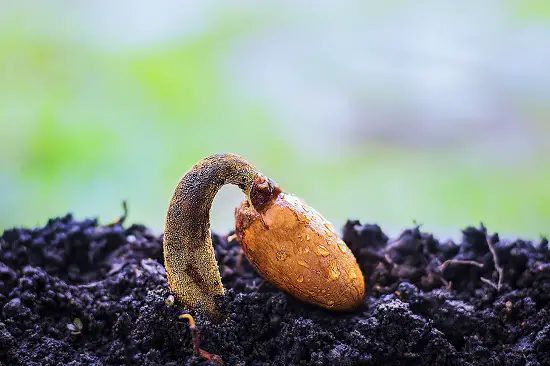
Think of a seed as an “escape pod” where the plant embryo is dormant, surrounded by a supply of food, and protected from the elements. At germination, the plant resumes growth and development that were suspended during seed dormancy.
Germination usually begins when the seed takes up water, a process known as imbibition. The hydrated seed expands, rupturing the coat. The inflow of water triggers metabolic changes that restart the growth of the embryo. Enzymes begin digesting stored nutrients in the endosperm or cotyledons, and these nutrients are transported to the growing regions of the embryo.

The embryonic root emerges first and grows downward from the germinating seed. Next, the embryonic shoot emerges, and a hook forms near its tip. The hook protects the delicate shoot tip by holding it down as it pushes up through the soil. As the shoot breaks through the surface, light stimulates the hook to straighten, gently lifting the tip out of the soil. The first foliage leaves then expand from the shoot tip and begin photosynthesis.
A plant is considered undergoing hypogeal germination if the cotyledons remain in the soil while the seed continues to grow whereas epigeal germination occurs if the cotyledons emerge from the soil as the seed germinates.
Other monocots use a different mechanism for breaking ground at germination. A protective sheath (called the coleoptile) surrounding the shoot pushes upward and breaks through the soil. The shoot tip then grows up through the tunnel provided by the sheath.
In the wild, only a small fraction of seedlings endures long enough to reproduce. The production of many seeds compensates for the odds against individual survival. A generally simpler and less hazardous alternative for plants is to reproduce asexually, a case which we also call vegetative propagation.
We will now review the different requirements for plants as we look at plant nutrition and its different mechanisms.
Next topic: Plant Nutrition and Transport
Previous topic: Plant Growth
Return to the main article: Plant Form and Functions
Download Article in PDF Format
Test Yourself!
1. Practice Questions [PDF Download]
2. Answer Key [PDF Download]
Copyright Notice
All materials contained on this site are protected by the Republic of the Philippines copyright law and may not be reproduced, distributed, transmitted, displayed, published, or broadcast without the prior written permission of filipiknow.net or in the case of third party materials, the owner of that content. You may not alter or remove any trademark, copyright, or other notice from copies of the content. Be warned that we have already reported and helped terminate several websites and YouTube channels for blatantly stealing our content. If you wish to use filipiknow.net content for commercial purposes, such as for content syndication, etc., please contact us at legal(at)filipiknow(dot)net
